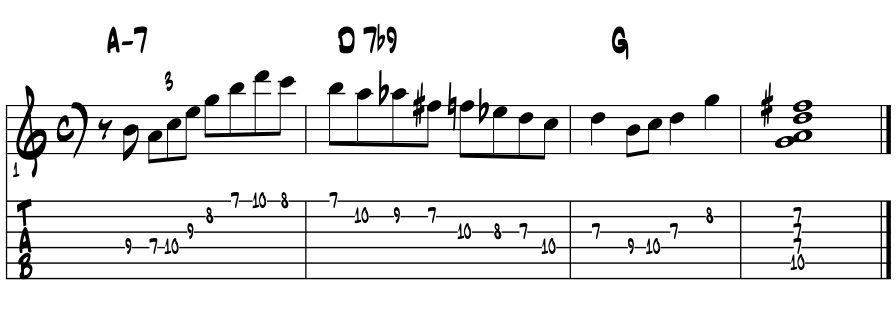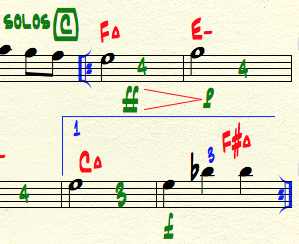In a nutshell / rhythm / syncopation. The dual nutshell here is specifically about the rhythm that 'motor' songs along and syncopations, the placing of special emphasis or 'accents' on certain beats within a looping rhythm pattern. These two words carry a lot of meaning in music; so a dual nutshell. From the songs we love we get the rhythms to make us dance and thus they become a best source for learning new rhythms. And with a few under our fingers, our own rhythm ideas begin to percolate up, and we source from our own energies of our heartbeat. Songs generally have a rhythm pattern which creates its groove. This we loop into a phrase of measures, oft repeated and thus motor along the song on along. And that 'groove' becomes a descriptive vocabulary word that spans our spectrum of styles, thus a wide wide range from nuanced gentle clave styled pulse of bossa nova to the BOOM BOOM BOOM of big quarter note Chicago blues and on into the Americana gallops :) Measure rhythms through time, notation by meter. The rhythm is easily measured once the math of it is understood, which takes some getting used to. Using fractions to set bar lines, we fill in our song's rhythm with its number of beats. Then we layer over the special accents that make this song, this song. Here we get two basic options; write out the rhythm pattern with standard notation and add a second layer of syncopations, this time through selecting some beats for emphasis. This brings in the 'dynamics' of loud and soft. So we 'ruff out' the rhythm lick with note values, then embellish and syncopate to taste. Common descriptive dynamics include loud / 'forte' or soft / 'piano' markings into the rhythm and syncopation of the groove. For example; double forte down to piano, means a big drop in volume. Example 1.
Cool ? |
A beginning. Going 'by ear' we find 2 and 4' within the 'big 4.' Example 2. |
 |
This '2 and 4' is the backbeat we use to make the swing. And while pretty straight forward, it's the Americana syncopation supreme as its pulse underlays all through Americana. In your listening to musics, count along and find this syncopation, own it true by snapping your fingers along, or clapping your hands too, dance a few steps and feel its pull :) |
The clave beat. This clave rhythm is a cool and fun one to master. A perfect one bar Latin flavored phrase that potentially loops on forever, or for as long as the dancers will twirl. Master this rhythm and syncopate it to your own heart's content. Write a song with the groove and teach it to the band. Further on, it'll become a foundational rhythm that ties in all sorts of variations through the styles. Clap along and master this essential rhythm. Example 3. |
|
Pops right on beat one and a strong close on beat four, setting up the next downbeat. Strong one accent leans us to the rock styles, and there's some 'clave' hits there. Explore. And if this rhythms brings some smiles for ya, write a song with this rhythm, your syncopations, and own it forever to know and to share. For this rhythm fills all sorts of dancefloors, tells a good story, global too. |
Eight notes and the triplet. Once things are in motion, with the big 4 booming away, and syncopating accents on the 2 and 4 to ensure we bring the swing, the melody line generally works an eighth note rhythm to move the lines along. Once grooving, we use a triplet figure, so three eighth notes for two, to set some gallop into the line, give it a 'shuffle' feel popular all along in blues musics. Add them up in a measure and voila ... the essential 12 / 8 feel. Compare the two. Example 4. |
 |
For many Americana improvising artists over the last century or so, the eighth note figure is the basic rhythm of their improvised melodic lines. Becoming an artistic signature, all combine to shape how we phrase our ideas. |
The triplet as a pick up. Using the triplet to 'jump start' a line is a common feature of jazz phrasing. While there's many ways to release this energy, the 1/8th note pickup is a mainstay in Americana. Thinking Two / Five / One in 'G' major. Example 4a. |
 |
Rhythm discipline. Luckily in our musical studies, discipline is no dirty word, but a measure of virtue and dedication to our craft. In playing rhythm, the discipline to churn out a steady and consistent pattern takes a high degree of focus. And when the rhythm pattern is set, as say with the above clave beat, it can become downright maddening to keep its steady rhythm going within jammin' contexts. That we can always come back to our original groove usually wins the day, and what happens in between, is the fun along the way. Certain rhythms in certain styles need a higher degree of discipline. Bossa nova rhythm guitar is as demanding as any; that we play a consistent rhythm pattern while making any number of chord changes within a song's chord progression. Not easy, and takes discipline, but that's the role we have to play sometimes to make the magic happen yes ? Discipline is not a dirty word around here. |
Review. So whatever your style and genres, relate these few rhythm elements into your music. Go through three or four songs, and master the rhythm they provide. Then mix in your own ideas too. Knowing that while '2 and 4' are true everywhere, somewhere, the triplet might not be front and center in the mix of heavier rockin' leaning styles. Just ask your instructor for help. Know that historically, the triplet syncopation leans us to blues and jazz styles, so a lot of Americana styles gets 'jazzed up' with various 'triplet feels.' Think 'rockabilly ?' |
The rest is easy really, put on some music to jamm to, or get some clicks going, and join in with your part in the music. And as you feel the pulse, imagine your rhythms and play them best U can. There's only one trick; try not to stop once the motor is running :) And when you find one you like, play it again a few times and make it one of yours. Fit in your rhythms to match up with these beats, and once solid, jazz em' up :) Do ask your instructor for help for finding songs in your style, to practice along with and emulate. Once they're learned, do the song your own way too. By working with a metronome, we can get a few super cools quickly, especially a perspective of how we each relate to any metronomically measured clicks we're presented with. A lot of this becomes about accuracy, we're physically making musical sounds into a flowing song, right along with a neat beat. And we want to know how well we can do that. A way to begin these super cools is to start some clicks, goes like this ... :) |
"Should you get lost, consider yourself lucky." |
wiki ~ Cy A. Adler |
References. References for this page's information comes from school, books and the bandstand and made way easier by the folks along the way. |
Find a mentor / e-book / academia Alaska. Always good to have a mentor when learning about things new to us. And with music and its magics, nice to have a friend or two ask questions and collaborate with. Seek and ye shall find. Local high schools, libraries, friends and family, musicians in your home town ... just ask around, someone will know someone who knows someone about music and can help you with your studies in the musical arts. |
|
Always keep in mind that all along life's journey there will be folks to help us and also folks we can help ... for we are not in this endeavor alone :) The now ancient natural truth is that we each are responsible for our own education. Positive answer this always 'to live by' question; 'who is responsible for your education ... ? |
Intensive tutoring. Luckily for musical artists like us, the learning dip of the 'covid years' can vanish quickly with intensive tutoring. For all disciplines; including all the sciences and the 'hands on' trade schools, that with tutoring, learning blossoms to 'catch us up.' In music ? The 'theory' of making musical art is built with just the 12 unique pitches, so easy to master with mentorship. And in 'practice ?' Luckily old school, the foundation that 'all responsibility for self betterment is ours alone.' Which in music, and same for all the arts, means to do what we really love to do ... to make music :) |
 |
"These books, and your capacity to understand them, are just the same in all places. Always bear in mind that your own resolution to succeed, is more important than any other one thing." |
|
Academia references of Alaska. And when you need university level answers to your questions and musings, and especially if you are considering a career in music and looking to continue your formal studies, begin to e-reach out to the Alaska University Music Campus communities and begin a dialogue with some of Alaska's finest resident maestros ! |
|
~ |


